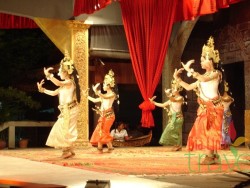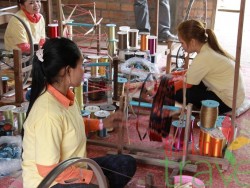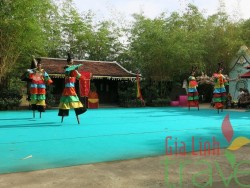Apsara dance
Art and Culture


Cambodia silk farm

Traditional show
The lines of culture distinguishing one country from another are blurring. The globalization of technology, information and finance has allowed wealthy countries to export not only their political and economic ideologies to developing countries but their traditions and values as well.
The Cambodian government has made aggressive rhetorical efforts to preserve the integrity of traditional Khmer culture, but younger generations are hungry for a change. In a seemingly uphill battle to maintain cultural identity in an increasingly homogeneous global community, one man has made it his mission to preserve the past for future generations.
Khmer Dance
Classical Dance of Cambodia The epic poem of Rama (Ramayana) is believed to have been revealed to a Hindu holy man named Valmiki by Brahma, the god of creation. This religious literary work, dating from about ad 4, is known in various versions throughout India and Southeast Asia. In Cambodia, the story has been set to music and dance and performed by the Royal Ballet since the 18th century. Although the epic is also known in the villages, where it is translated orally or dramatized in the popular shadow puppet theater, the ballet was traditionally a courtly art performed in the palace or for princely festivals. The music of the ballet is performed by the Pinpeat orchestra, which is made up of traditional xylophones, metallophones, horizontal gongs, drums, and cymbals
Khmer classical dance derived from Indian court dance, which traces its origins to the apsarases of Hindu mythology, heavenly female nymphs who were born to dance for the gods. The traditions of Thailand and Java (in Indonesia) also influenced the music and dance of Cambodia. In classical Cambodian dance, women, dressed in brightly colored costumes with elaborate headdresses, perform slow, graceful movements accompanied by a percussive ensemble known as the pinpeat. Pinpeat orchestras include drums, gongs, and bamboo xylophones. In Cambodia’s villages, plays performed by actors wearing masks are popular. Shadow plays, performed using black leather puppets that enact scenes from the Reamkern, are also enjoyed. Folk dancing is popular in rural Cambodia and is performed spontaneously to a drumbeat.
Apsara Dance
At the heart of classical form is the Apsara, the joyful, almost wanton dancer whose images are everywhere. Princess Buppha Devi, who currently serves as the Minister of Culture, is a master of Apsar dancing, which dates to the 1st century. The graceful movements of the Apsara dancers, adorned with gold headdresses and silken tunics and skirts, are carved on the walls of many of the temples at Angkor. Estimates are that there were 3,000 Apsara dancers in the 12th century court of King Jayavarman VII.
Over the centuries Khmer dancing lent its influence to the classical ballet of neighboring countries, and some of its postures and movements are similar to other Southeast Asian dance forms. But according to Princess Buppha Devi, “The Khmer kingdom started its traditions in the 8th century, 500 years before Thailand.” In 1400, with the sacking of the Angkor Empire, the Apsara dancers were seized and taken to Thailand. Apsara dancing is one of two elements of classical ballet, the other being “today” dancing, the depiction of early myths. Many of the dances involve performing a fragment of the Ramayana, the ancient Indian epic that is one and a half times as long as the Odyssey. Others are based on the legendary battles and mythical sagas carved in bas relief on the walls of the temples of Angkor-including the Churning of the Sea of Milk, the great battle between gods and demons for the holy liquid that gives immortality. There are 100 dances and dramas.
Khmer Music
There are two kinds of traditional music: one is the Pin Peath with stringed and percussion instruments and the other the Mohory with only stringed instruments. The different instruments are: Pin Peath is a group of instruments which have Roneath (xylophone in metal or bamboo), Kong (percussion instrument surrounding the player), a pear of Skor Thom (a very big drum, which has two faces, for making the rhythm), Sampho (a big drum,which has two faces, for making the rhythm), Sro Lai (a big recorder),Chhoeng (percussion instrument hitting each other for making rhythm). This kind of music is used to accompany dances, praying to God or spirit and other ceremonies. Mohory is a group of instruments, which have Khoem (with 35 horizontal strings instrument), Ta Khe (with 3 horizontal strings instrument), Tro (with vertical strings instrument), Skor Dai (a small drum for making rhythm), Khloy (recorder) and Chhoeng.
This kind of music is used to accompany dance, theatre, wedding and other ceremonies. There are 4 to 6 % of children attend these courses and they start learning all the traditional Khmer instruments, and choose one they prefer to form the group.
Khmer People
Ethnic Composition
The population of Cambodia today is about 10 million. About 90-95 percent of the people are Khmer ethnic. The remaining 5-10 percent include Chinese-Khmers, Khmer Islam or Chams, ethnic hill-tribe people, known as the Khmer Loeu, and Vietnamese. About 10 percent of the population lives in Phnom Penh, the capital, making Cambodia largely a country of rural dwellers, farmers and artisans.
The ethnic groups that constitute Cambodian society possess a number of economic and demographic commonalties- for example. Chinese merchants lived mainly in urban centers and play middlemen in many economic cycles, but they also preserve differences in their social and cultural institutions. They were concentrated mostly in central and in southeastern Cambodia, the major differences among these groups lie in social organization, language, and religion. The majority of the inhabitants of Cambodia are settled in fairly permanent villages near the major bodies of water in the Tonle Sap Basin-Mekong Lowlands region. The Khmer Loeu live in widely scattered villages that are abandoned when the cultivated land in the vicinity is exhausted. The permanently settled Khmer and Cham villages usually located on or near the banks of a river or other bodies of water. Cham villages usually are made up almost entirely of Cham, but Khmer villages, especially in central and in southeastern of Cambodia, typically include sizable Chinese communities.
The Khmer Loeu
The Khmer Loeu are the non-Khmer highland tribes in Cambodia. The Khmer Loeu are found namely in the northeastern provinces of Rattanakiri, Stung Treng, Mondulkiri and Crate. Most Khmer Loeu live in scattered temporary villages that have only a few hundred inhabitants. These villages usually are governed by a council of local elders or by a village headman. The Khmer Loeu cultivate a wide variety of plants, but the man crop is dry or upland rice growth by the slash-and-burn method. Hunting, fishing, and gathering supplement the cultivated vegetable foods in the Khmer Loeu diet. Houses vary from huge multi-family long houses to small single family structures. They may be built close to the ground or on stilts. The major Khmer Loeu groups in Cambodia are the Kuy, Phnong, Brao, Jarai, and Rade. All but about 160,000 Kuy lived in the northern Cambodia provinces of Kampong Thom, Preah Vihear, and Stoeng as well as in adjacent Thailand.
The Cham
The Cham people in Cambodia descend from refugees of the Kingdom of Champa, which one ruled much of Vietnam between Gao Ha in the north and Bien Hao in the south. The Cambodian Chams are divided into two groups, the orthodox and the traditional- base on their religious practices. The orthodox group, which make up about one-third of the total number of Chams in the country, were located mainly in Phnom Penh – Oudong area and in the provinces of Takeo and Kapot. The traditional Chams were scattered throughout the midsection of the country in the provinces of Battambang, Kompong Thom, Kompong Cham, and Pursat. The Chams of both groups typically live in villages inhabited only by other Chams; the villages may be along the shores of watercourses, or they may be inland. The inhabitants of the river villages engage in fishing and growing vegetables. They trade fish to local Khmer for rice. The women in these villages earn money by weaving. The Chams who live inland support themselves by various means, depending on the villages. Some villages specialize in metalworking; others raise fruit trees or vegetables. The Chams also often serve as butchers of cattle for their Khmer Buddhist neighbors and are, in some areas, regarded as skillful water buffalo and ram breeders.
The Chinese
The Chinese in Cambodia formed the country es largest ethnic minority. Sixty percent of the Chinese were urban dwellers engaged mainly in commerce; the other 40 percent were rural residents working as shopkeepers, as buyers and processors of rice, palm sugar, fruit, and fish, and as money lenders. It is estimated that 90 percent of the Chinese in Cambodia were in commerce and that 92 percent of those involved in commerce in Cambodia were Chinese. In rural Cambodia, the Chinese were moneylenders, and they wielded considerable economic power over the ethnic Khmer peasants through usury. The Chinese in Cambodia represented five major linguistic groups, the largest of which was the Teochiu (accounting about 60 percent), followed by the Cantonese (accounting about 20 percent), the Hokkien (accounting about 7 percent), and the Hakka and the Hainanese (each accounting for 4 percent). Those belonging to the certain Chinese linguistic groups in Cambodia tended to gravitate to certain occupations. The Teochiu, who make up about 90 percent of the rural Chinese population, ran village stores, control rural credit and rice marketing facilities, and grew vegetables. In urban areas they were often engaged in such enterprises as the import-export business, the sale of pharmaceuticals, and street peddling. The Cantonese, who were the majority of Chinese groups before Teochiu migrations began in the late 1930s, live mainly in the city. Typically, the Cantonese engages in transportation and in constriction, for the most part as mechanics or carpenters. The Hokkien community was involved import-export and in banking, and it included some of the countryfs richest Chinese. The Hainanese started out as pepper growers in Kompot Province, where they continued to dominate that business. Many moved to Phnom Penh , where, in the late 1960s, they reportedly had virtual monopoly on the hotel and restaurant business. They also often operated tailor shops. In Phnom Penh, the newly arrived Hakka were typically folk dentists, sellers of traditional Chinese medicines, and shoemakers.
The Vietnamese
The Vietnamese community is scattered throughout southeastern and central Cambodia. They were concentrated in Phnom Penh, and in Kandal, Prey Veng, and Kampong Cham provinces. No close cultural or religious ties exist between Cambodia and Vietnam. The Vietnamese fall within the Chinese culture sphere, rather within the Indian, where the Thai and Khmer belong. The Vietnamese differ from the Khmer in mode of dress, in kinship organization, and in many other ways- for example the Vietnamese are Mahayama Buddhists while most of the Cambodians are Theravada Buddhists. Although Vietnamese lived in urban centers such as Phnom Penh, a substantial number lived along the lower Mekong and Bassac rivers as well as on the shores of the Tonle Sap, where they engaged in fishing.
